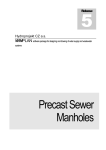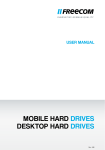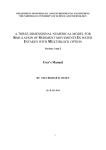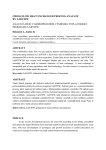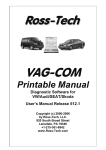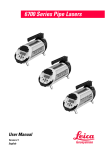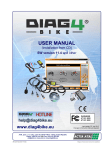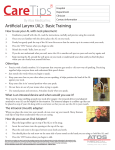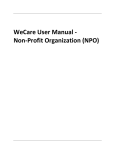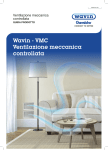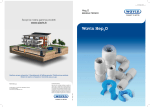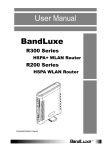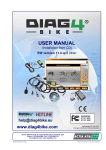Download User`s manual of Plastic Sewer Manholes and Inspection Chambers
Transcript
2 Release Hydroprojekt CZ, a.s. WINPLAN software package for designing and drawing of water supply and wastewater systems VSV-ENGINEERING s.r.o. Plastic Sewer Manholes and inspection chambers WINPLAN software package for designing and drawing of water supply and wastewater systems User’s manual of Plastic Sewer Manholes and Inspection Chambers 2005 (v. 2.0) © 1995 – 2005 Hydroprojekt CZ, a.s. Táborská 31 • 140 16 Praha 4 Phone +420 261 102 497 • Fax +420 261 215 186 Internet http://WWW.HYDROPROJEKT.CZ/WINPLAN E-mail [email protected] Plastic Sewer Manholes and Inspection Chambers 2005 (Release. 2.0) User’s manual Contents User’s manual of ...................................................................................................................................................... 1 Plastic Sewer Manholes ........................................................................................................................................... 1 and Inspection Chambers 2005 (v. 2.0) ................................................................................................................... 1 1 Foreword .......................................................................................................................................................... 4 2 Requirements for hardware and software, installation...................................................................................... 6 3 Initial description of the program ...................................................................................................................... 6 4 Inputs and outputs of the program.................................................................................................................... 8 5 Working with the program................................................................................................................................. 9 5.1 6 Description of menus, buttons and dialog windows commands...................................................................... 12 6.1 6.2 6.3 6.4 6.5 6.6 6.7 6.8 6.9 7 Limiting conditions ....................................................................................................................................................... 11 File Menu ..................................................................................................................................................................... 13 Edit Menu..................................................................................................................................................................... 17 Tools Menu .................................................................................................................................................................. 20 View Menu ................................................................................................................................................................... 27 Help Menu.................................................................................................................................................................... 29 Manufacturer of manholes and inspection chambers .................................................................................................. 30 Left-hand side - list of manholes/inspection chambers files ........................................................................................ 30 Table ............................................................................................................................................................................ 31 Editing dialog ............................................................................................................................................................... 32 Description and general rules of sewer manholes assembly.......................................................................... 34 Page 2 WINPLAN Plastic Sewer Manholes and Inspection Chambers 2005 (Release. 2.0) Page 3 User’s manual WINPLAN Plastic Sewer Manholes and Inspection Chambers 2005 (Release. 2.0) User’s manual 1 Foreword Dear friends, the "PLASTIC SEWER MANHOLES AND INSPECTION CHAMBERS 2005 (v. ´2.0)“ program, which comes to your hands, is the new version of program, which complements popular and abundantly used program for concrete manholes "PRECAST SEWER MANHOLES". Besides current production catalogues of the manufacturer Wavin this new version offers anew also a language version of the program. Simultaneously with this program inclusion of next manufacturer of plastic manholes is prepared and the "PLASTIC SEWER GULLIES" program is being developed as well. All these programs continue to be the components of the WINPLAN system software package for designing and drawing of water supply and wastewater systems (particularly pipe lines) on PCs in Microsoft Windows. The particular programs of this package may be used independently (they have autonomous inputs and outputs). If you are the owner of the program ”free version” only, which is distributed to designers and project planners as a service of companies like Wavin and Bocr (under preparation), within the promotion of their products, you do not need the hardware key (hardlock) for the program running. However, you do not have the possibility to load automatically the data from a longitudinal profile of sewer processed in the WINPLAN system. This function is a feature of the ”full version” only, which is sold and distributed by Hydroprojekt CZ. With the ”free version” you have to enter all the necessary data via keyboard or with help of a mouse. Concerning the program outputs all the versions are equivalent. In the free versions of course the products of one company only are listed – these of the company distributing the program. The overall structure of the WINPLAN software system is obvious best from the following block diagram. The rectangles represent the particular modules of the system (programs); the arrows then represent their links at cooperation and sharing the data. Page 4 WINPLAN Plastic Sewer Manholes and Inspection Chambers 2005 (Release. 2.0) User’s manual HYDRONet MAPPING ODULA SCHEMATIC LONGITUDINAL PROFILE ROUTE DIGITAL TERRAIN MODEL SEWER SYSTEM LONGITUDINAL PROFILE WATER SUPPLY SYSTEM LONGITUDINAL SEWER MANHOLES AND INSPECTION CHAMBERS WATER SYSTEM ASSEMBLY SCHEME LAYOUT All information on software (sale and user support) are provided by the Hydroinformatics Team of Hydroprojekt CZ, a.s., Táborská 31, 140 16 Praha 4. The basic data on programs may be found on the following web site: www.hydroprojekt.cz/Winplan/. To send inquiries and requests for information the [email protected] e-mail address may be used. Telephonic information may be obtained at phone number +420 261 102 497 or facsimile number +420 261 215 186. The software system elaborators’ team would be grateful for any of your suggestions, inquiries and comments, which might help to the system improvement or extension. We wish you a pleasant and efficient work with our tools. Page 5 WINPLAN Plastic Sewer Manholes and Inspection Chambers 2005 (Release. 2.0) User’s manual 2 Requirements for hardware and software, installation The ”PLASTIC SEWER MANHOLES AND INSPECTION CHAMBERS 2005” program of the WINPLAN SW package is designed for the MS Windows 98 and higher PC operation systems. The program has no special demands on hardware. The graphic card should enable operation of Windows with at least 800 x 600 resolution at 16 colours. The installation to hard disc from the attached CD is run automatically by the SETUP.EXE installation program, which is easily started by a double click of the left mouse button on program name in the "File manager" or in the "Explorer". The Install-Shield Wizard will lead you through the installation. You would be asked to select and prove the program location and the program folder. The Wizard offers a standard setting, which is satisfactory in a majority of cases. 3 Initial description of the program The ”PLASTIC SEWER MANHOLES AND INSPECTION CHAMBERS 2005” program is intended for design of plastic sewer manholes and inspection chambers produced by the Wavin company. Downloading of relevant data from the „Sewer System longitudinal profile“ program of the WINPLAN SW system data files is possible. The main purpose of the program is to create the model drawings of a selected type of sewer manholes and inspection chambers, manhole and inspection chamber assembly schemes created by the program, table of manhole and inspection chamber elements, table of drop-manhole elements and “in situ” connections, table of base elements and covers. These tables comprise the detailed data for the parts (elements) ordering and for detailed design of the projects. Further the program enables to create an order of the shaft elements including covers. The “full version” enables also loading of relevant data from the files of longitudinal profile within the WINPLAN system. User’s interface of the program is divided into 4 parts: The main roll-down menu with the program title, with quick access keys (buttons) and manufacturer selection Left-hand panel, where all the manholes are synoptically shown in all open data files Table in bottom part of a screen, with detailed data of each manhole (table of manholes, table of base elements,..) Editing dialog with data of the currently designed manhole and its schematic sketch. The program enables working with more files simultaneously. Each file has an own editing window with data and schematic sketch of the currently designed manhole. Switching among them is possible Page 6 WINPLAN Plastic Sewer Manholes and Inspection Chambers 2005 (Release. 2.0) User’s manual either via the „View“ main menu by selection of relevant window, or by clicking of the left mouse button at any manhole of the required file in the left-hand panel, or by clicking of the right mouse button at file name. The user also may select the editing windows arrangement into tiles or cascade in the „View“ menu and then move by pointing to the desired working editing window by the mouse. Page 7 WINPLAN Plastic Sewer Manholes and Inspection Chambers 2005 (Release. 2.0) User’s manual 4 Inputs and outputs of the program Program inputs: Besides the standard opening of the .SPL file the program enables loading of both the .SEW file of the „SEWER LONGITUDINAL PROFILE release 4.0“ and .SXML file of the „SEWER LONGITUDINAL PROFILE release 5.0“ programs. Program outputs: A) Output to data file: .SPL - data file of the PLASTIC SEWER MANHOLES AND INSPECTION CHAMBERS program (maximum number of manholes in one file is not limited) .DXF - drawing data file of the CAD programs (a “package” type file, which cannot be opened directly, see export to DXF) B) Output to printer: (in A4 landscape format) - print of the model drawings - print of the manholes and inspection chambers (shaft elements) table - print of the base elements table - print of manholes assemblies - print of drop-manholes table and „in situ“ - print of covers table (in A4 portrait format) - order of shaft elements incl. base elements, covers Page 8 WINPLAN Plastic Sewer Manholes and Inspection Chambers 2005 (Release. 2.0) User’s manual 5 Working with the program Working with the „PLASTIC SEWER MANHOLES AND INSPECTION CHAMBERS“ program at design of manholes is described in this chapter. Working in particular dialog windows is a topic of following chapters. User of the full version will select the manufacturer and executes downloading (importing) of longitudinal profile data and adjustment of data errors consequently (“File” Menu) or he/she may submit the particular manholes data in the editing dialog. User of a free version must submit all the manholes in the editing dialog. The submitting of manholes itself proceeds as follows. The user creates a new file by pressing a button or selecting „New“ command in “File” menu. A new editing window appears. Then in the quickaccess keys bar a manufacturer is selected. This data is common for all manholes of the given file. Then a new manhole may be inserted and its data submitted. The „New manhole“ button in the editing dialog inserts the manhole. Program asks for sequence and identification of the manhole. Each manhole must have an unambiguous sequence number. The sequence number determines sequence of the manhole in a file. Identification of the manholes is arbitrary and it may be repeated within the framework of one file. Identification must not be empty. The program checks whether a manhole with identical serial number exists. If so, the program offers insertion of a manhole with a shift of the following manholes numbering. It is possible to change the identification anytime later. After insertion of the manhole the sequence may be modified only by the manhole shifting to other position with help of a mouse in the left-hand panel (by „drag and drop“ function). Then the program asks for a new identification and sequence of the manhole. If no manhole was inserted, the dialog editing fields are inaccessible. Submitting proceeds by submitting of the outlet elevation (internal pipe bottom) of base element and ground elevation (terrain) and the manhole terrain ground super-elevation when relevant. The elevations may be relative (negative measured from terrain). It is also possible to submit the elevation differences only and the program will calculate the ground level automatically. Simultaneously with submitting the program calculates height of the manhole (sum of the used elements heights), ideal height of a manhole (difference of elevations submitted plus the ground super-elevation when relevant). If the editing is correct, a manhole schematic sketch appears also after each modification. At an incorrect editing the schematic sketch disappears, at the same time an error message appears in the status line of the editing window (e.g. „manhole is too high “). After editing of level conditions the user selects the piping material. Based on the selected material the list of existing outlet DN is updated. The program offers the existing combinations only. Then the user selects the type of base element. The program offers all manufacturer’s options for the combination of DN and material. There are two ways of selection of the base element type; selection in the “Type of the base element” dialog or by ticking of particular connections together with settings of corresponding connection angles. The program checks the input data again and it offers the manufactured Page 9 WINPLAN Plastic Sewer Manholes and Inspection Chambers 2005 (Release. 2.0) User’s manual base element types only. In case the required combination of piping material, DN and angle correspond to any manufactured type a schematic sketch of base element appears. If such combination do not exist the schematic sketch is crossed out with red lines. Once the base element type is edited correctly the user selects a manhole cover in the „Cover Selection“ dialog opened by pressing of relevant button. The manhole/inspection chamber may be left without any cover, then it is necessary to tick „Without cover“ option, otherwise the program reports an error („Wrong cover“). The program enables editing of up to three drop-connections into one drop-manhole. After ticking the „Drop-manhole“ box with relevant connection the „Entry and correction of drop-manhole” dialog window is called by pressing of „Drop-manhole“ button. In the dialog the drop-manhole DN and the piping bottom height from the outlet bottom of base element are determined. The program checks whether the dropmanhole does not mouth into a base element or into a joint of two shaft elements. The program enables editing of up to three „in situ“ connections through the corresponding editing dialog. All changes of the manhole/inspection chamber data are immediately projected into all tables. The current manhole may be changed anytime by mouse pointing and clicking to its identification in the lefthand panel or by pressing of the „Previous manhole/inspection chamber“ or „Next manhole/inspection chamber“ quick-access keys. With the current shaft the program enables to return in submitting to arbitrary preceding step („Undo“ and „Redo“ buttons). Once the current manhole is replaced with another all sequence preceding submitting steps is deleted. The user may possibly change the set of elements of automatically assembled manhole/inspection chamber after ticking the „Individual assembly“ box in the editing dialog. The user may arbitrarily change sequence and assembly of elements of manhole/inspection chamber in dialog „Individual manhole/inspection chamber assembly“. The program checks the link between individual components only. Similarly, the height of manhole shaft of small diameter may be modified by pressing the corresponding button. Before leaving the dialog the program asks, whether it may change the manhole height of the current manhole to a value calculated based on the individual assembly. The user will inspect the composition of automatically assembled drop-manholes, checks and adjusts them. He will carry out a comprehensive check of the all manholes/inspection chambers. He will inspect the drawings and tables, print the drawings, tables, orders. The procedure of individual assembly: The program enables as well using of other options of data editing apart from the traditional way: 1/ The individual assembly of manhole/inspection chamber DN 1000. This option is used for editing of automatically assembled manholes/inspection chambers. If the arrow is pointing at the particular element – the element can be replaced or deleted If the arrow is pointing to the gap between two elements, the another chosen element can be added. Page 10 WINPLAN Plastic Sewer Manholes and Inspection Chambers 2005 (Release. 2.0) User’s manual 2/ Placing and ordering of an atypical base element production for manholes DN 600 and DN 1000 using the corresponding option in the dialog together with submitting of such connection angles, which do not comply with the standard production catalogue. 3/ Individual specification of the manhole shaft height. When the option “Change height of the shaft” is ticked the shaft height may be modified by switching the arrows in dialog. However the height must be the multiple of “lengths given by possible cutting interval of pipe”. The interrelation between the manhole/inspection chamber actual height and the ideal height could be influenced with this approach. 5.1 Limiting conditions The program enables designing of plastic sewer manholes and inspection chambers with internal diameter of DN 315 and DN 425 for piping ranges from DN 110 to DN 450 and sewer manholes with internal diameter of DN 600 and DN 1000 for piping ranges from DN 160 to DN 400. Maximum depth of a manhole without professional structural engineering assessment for DN 315, 425 and 600 corresponds to maximum shaft length of 6 m or similarly 5 m for DN 1000. (The program enables to design even deeper manholes – up to 15 m.) The minimum manhole heights corresponds to the minimum structural height of particular manhole/inspection chamber type. Maximum amount of the piping mouthed into a manhole base element is one outlet, the 1st connection (main) and secondary connections Nos. 2 and 3. Minimum amount of the piping mouthed into a manhole base element is outlet only, at a terminal manhole/inspection chamber option. Delta H for plastic base elements is insignificant or 0 mm. Axe angles of the connections (against the outlet) acc. to manhole clock must be within 90° to 270° range. The counter-direction junction is not admissible. Arrangement of all connections with respect to selected profiles of piping must be such to prevent overlapping of the individual piping including relevant inserts, and to ensure sufficient gaps among inserts, enabling the manhole base element manufacturing. Program checks the spatial arrangement of connections acc. to selected material. The shaft heights are limited with the cutting interval of shaft pipe; 55 mm for shafts of DN 315, 75 mm for shafts of DN 425, 100 mm for shafts of DN 600. The lowest shaft of DN 1000 is 125 mm high. Page 11 WINPLAN Plastic Sewer Manholes and Inspection Chambers 2005 (Release. 2.0) User’s manual 6 Description of menus, buttons and dialog windows commands Fig. 1 – user’s interface of the “Plastic Sewer Manholes and inspection chambers 2005” program Controlling of the program proceeds in the basic user’s interface of the application, i.e. in the “MANHOLES/INSPECTIONS CHAMBERS DATA” window. The current *.SPL file name appears on the left-hand side of the window name in the main title. In the main menu there are standard commands for working with data (“File” menu), commands for editing of data (“Edit” menu and “Tools” menu), commands for working with windows (“View” menu) and commands for calling of help (“Help” menu). A majority of commands has also the quick access buttons. Among the buttons there is a roll-down menu for selection of a manufacturer common for the whole file. The editing dialog with data of the currently designed manhole/inspection chamber and its schematic drawing is in the centre of working area. If there is no manhole/inspection chamber in the file, all the editing fields are inactive. The left-hand panel displays the open data files with all inserted manholes/inspection chambers. The particular print outputs (tables) are scheduled and displayed in a table in bottom part of the screen. Page 12 WINPLAN Plastic Sewer Manholes and Inspection Chambers 2005 (Release. 2.0) 6.1 User’s manual File Menu Items of the "File" menu serve for working with the manholes data files, for setting of an empty data file for insertion of new data, for loading (importing) of longitudinal profile data, for printing of results, for selection of a current printer for print preview and for the program termination. Fig. 2 –File menu New: It will clear down the data of the current data file and assign a name to a new data file [WITHOUT NAME.SPL]. The user is informed on the necessity to save changes of the current file data. Open: It will clear down the data of the current data file (the user is informed on the necessity to save changes of the data). With help of a standard dialog window a selection of the required data file is enabled. Close: The current data file is closed and removed from the left-hand panel (the user is informed on the necessity to save changes of the data). Page 13 WINPLAN Plastic Sewer Manholes and Inspection Chambers 2005 (Release. 2.0) User’s manual Save: It saves the current data file to disc. If the command is selected with a new data file, the “Save under name” command is switched automatically. Save as: It saves to disc the current data file under the user name with help of a standard dialog window. This command is used at first saving of a file or at creation of mutations of the existing files. Import into the new file: The program enables importing of data from the „ LONGITUDINAL PROFILE OF SEWER“ program of the WINPLAN system. The new file containing loaded data is created. The program will load the selected .SEW or .SXML data file with help of a dialog. The program will report the amount of manholes loaded. In further dialog it will list the manholes/inspection chambers, those that must be adjusted or deleted are marked with an asterisk. It is always necessary for all manholes to check and adjust the piping material to a material, which is in the offer = it corresponds to the catalogue of manufacturer selected before the data importing. It is necessary to correct all the reported errors, to enable the program work with the data. The most frequently reported error is a too low manhole/inspection chamber or wrongly determined axe angle of connection. Too big delta h is not monitored during the data loading. It must be corrected consequently, or the particular manhole with big delta h must be designed as a drop-manhole. If in the longitudinal profile no different elevations of the outlet base element and the 1st connection (drop-manhole) are submitted, the delta h is determined automatically as a sum of the manhole/inspection chamber radii multiplied by longitudinal gradient in the sections upstream and downstream the manhole/inspection chamber. This dialog is not part in so-called ”free version”, which is distributed free-ofcharge. With the ”free version” you have to submit all the necessary data from the keyboard or with help of a mouse. Page 14 WINPLAN Plastic Sewer Manholes and Inspection Chambers 2005 (Release. 2.0) User’s manual Import into the active file: The program enables importing of data from the „ SEWER LONGITUDINAL PROFILE“ program of the WINPLAN system. In this case the relevant loaded data are added next the currently edited manhole of the active file. The program will load the selected .SEW or .SXML data file with help of a dialog. The program will report the amount of manholes/inspection chambers loaded. In further dialog it will list the manholes, those that must be adjusted or deleted are marked with an asterisk. It is always necessary for all manholes to check and adjust the piping material to a material, which is in the offer = it corresponds to the catalogue of manufacturer selected before the data importing. It is necessary to correct all the reported errors, to enable the program work with the data. The most frequently reported error is a too low manhole/inspection chamber or wrongly determined axe angle of connection. Too big delta h is not monitored during the data loading. It must be corrected consequently, or the particular manhole with big delta h must be designed as a drop-manhole. If in the longitudinal profile no different elevations of the outlet base element and the 1st connection (drop-manhole) are submitted, the delta h is determined automatically as a sum of the manhole radii multiplied by longitudinal gradient in the sections upstream and downstream the manhole. This dialog is not part in so-called ”free version”, which is distributed free-ofcharge. With the ”free version” you have to submit all the necessary data from the keyboard or with help of a mouse. Export of tables into MS Excel format: Fig. 3 – dialog for export of manhole/inspection chamber into Excel Page 15 WINPLAN Plastic Sewer Manholes and Inspection Chambers 2005 (Release. 2.0) User’s manual The command enables export of selected tables into MS Excel format. Printer setup: Fig. 4 – dialog for printer setup Dialog enables selection of a printer and setting of printing options (orientation of paper etc.). The program automatically sets the orientation of print for printing of tables and for printing of orders. We do not recommend changing this setting. Preview and print of tables: Fig. 5 – dialog for selection of schedules and tables for printing Page 16 WINPLAN Plastic Sewer Manholes and Inspection Chambers 2005 (Release. 2.0) User’s manual By ticking in relevant boxes of dialog window it is possible to select, which of the pages will be printed or browsed. Model drawings and size tables may be browsed and printed always. Other if the program does not detect any error in data only. The outputs appear on the screen in the same format, in which they will be printed. It is possible to print any page both independently and all together from the browsing dialog. Preview and printing of the order: The order of the manhole/inspection chamber elements incl. covers appears on the screen in the same format, in which it will be printed. It is possible to print any page both independently and all together from the browsing dialog. Send by E-mail: It enables to send the current data as an attachment of a message. After selection of this command the window for writing of a message with attached file of current data appears. Exit: It terminates the program run in a legal way with an inquiry concerning saving of the modifications carried out in the data file. 6.2 Edit Menu Items of the "Edit" menu serve for recalling of particular dialog windows, in which it is possible to submit the data of a current manhole or information on the designer or they enable a check of the submitted data. Fig. 6 – Edit menu Page 17 WINPLAN Plastic Sewer Manholes and Inspection Chambers 2005 (Release. 2.0) User’s manual Undo: The command will delete recent modifications made in current manhole/inspection chambers data (step backward). Redo: The command will do again the modification recently cancelled by “Undo” command in current manhole data (step forward). Insert the new manhole/inspection chamber: Fig. 7 – dialog for insertion of a new manhole The command will insert the new manhole/inspection chamber into the data file. In the dialog we submit the sequence and identification. Delete the manhole: Fig. 8 – dialog for deletion of the manhole The command will delete current manhole/inspection chamber from the data file. Next manhole: Previous manhole: The commands enable to list in the sequence of manholes in the opened file and to set the selected manhole as the current one. Page 18 WINPLAN Plastic Sewer Manholes and Inspection Chambers 2005 (Release. 2.0) User’s manual Project and designer data: Fig. 9 – dialog for inserting of project and designer data Common data for identification card of drawings and tables. Order product list: Fig. 10 – dialog containing a product list for order A dialog will appear, in which all the products and elements used in the current file are listed. The user may modify the list (erase lines, change amount of pieces). Page 19 WINPLAN Plastic Sewer Manholes and Inspection Chambers 2005 (Release. 2.0) User’s manual Customer order data: Fig. 11 – dialog containing customer data for order Common data for order will be completed. 6.3 Tools Menu Fig. 12 – Tools menu Page 20 WINPLAN Plastic Sewer Manholes and Inspection Chambers 2005 (Release. 2.0) User’s manual Base element selection: Fig. 13 – Dialog of the base element type selection The selection is done by marking of corresponding base element type. The program offers the manufactured types only. Dialog is recalled from the Editing dialog by button. Cover selection: Fig. 14 – dialog of the covers selection Page 21 WINPLAN Plastic Sewer Manholes and Inspection Chambers 2005 (Release. 2.0) User’s manual Highlighting of relevant line carries out selection of the cover. Dialog is recalled from the Editing dialog by button. Individual assembly: Fig. 15 – dialog for individual assembly of a manhole/inspection chamber The tool is accessible after ticking the „Individual assembly“ box in the manhole submitting dialog only. In the dialog, which appears, it is possible to assemble the current manhole from all available elements of the manufacturer. The logical link among elements used is not checked. After pressing of the OK button it is checked only, whether the elements link to each other (if the upper width of the element is similar with the width of the next element below). In case the set is not all right, the user must adjust it. It is possible to change height of the manhole by individual assembly (design). The user is informed on the change of height and if he/she does not agree, he/she may adjust the set. It is possible to recall the dialog directly from the Editing dialog by button located to the right from the individual assembly tick box. Page 22 WINPLAN Plastic Sewer Manholes and Inspection Chambers 2005 (Release. 2.0) User’s manual In the beginning of using the “Individual Assembly” dialog the automatic design of the manhole/inspection chamber will be displayed. In the dialog it is possible to change the assembly of the manhole with help of buttons acc. to individual idea by re-writing, editing from the catalogue and also by erasing of particular elements of the automatically created manhole (with exception of the base element). Arrow in the manhole assembly always indicates the upper part of the element. The "Move up" and "Move down" buttons serve for moving of selected element up or down. The element is selected when the sign „“ points towards it. The „“ and „“ buttons serve for shift of the cursor, indicating to elements, upwards and downwards. The „Replace“ button replaces the active element (indicated by cursor) with the element selected in the right-hand part of the dialog (catalogue). The „Delete“ button will erase the element indicated by cursor. The „Insert“ button will insert the element selected in the right-hand part of the dialog. The „OK“ button will confirm changes and close the dialog; the “Cancel” button will revoke the changes and close the dialog. Page 23 WINPLAN Plastic Sewer Manholes and Inspection Chambers 2005 (Release. 2.0) User’s manual Entry and correction of drop-manhole: Fig. 16 – dialog for entry and correction of a drop-manhole data The item is only available in case of ticking at least one „drop-manhole“ box next to connections in the manhole submitting dialog. In the dialog, which will appear, it is possible to submit DN of a drop-manhole connection and height measured from the outlet bottom. The program checks, whether the dropmanhole connection is not in the base element or in two elements joint. The dialog may be recalled directly from the Editing dialog by a button. If the delta h (determined or counted from the longitudinal profile) is bigger than difference of the base element height and a sum of outlet DN and the minimum mouthing of insert below the base element edge (150 mm), it is necessary to mark this manhole in the editing dialog in relevant connection as a drop-manhole (tick the "drop-manhole" box) and to solve it as a dropmanhole. Then the delta h becomes the H height of the drop-manhole and the program does not report a wrong data of big delta h. Here DN of connection is DN1, DN2 and dh is selected. The automatically assembled drop-manhole will be displayed. Page 24 WINPLAN Plastic Sewer Manholes and Inspection Chambers 2005 (Release. 2.0) User’s manual The manhole will be displayed even when the basic data are submitted wrongly; it is necessary to carry out a check from the editing dialog. By the "Check" button it is necessary !!! to check correctness of the outlet junction to shafts and/or to replace the shaft elements (always after switching to individual assembly dialog), or to change H. The automatic assembly does not monitor correctness of the connection pipe junction into the shaft element. Manholes/inspection chambers overall check-up: Fig. 17 – dialog for manholes overall check-up Fig. 18 – dialog for manholes overall check-up Information on shortcomings and errors is provided here. At wrongly (insufficiently) completed data the program will not print relevant outputs – tables. The correction of data is necessary or defect manholes must be deleted. The errors may be represented by the manhole data, drop-manhole or in case no cover is selected. (If you want to design a manhole without cover, it must be identified as such). Renumbering of manholes: The program will re-number the submitted manholes starting from 1. Page 25 WINPLAN Plastic Sewer Manholes and Inspection Chambers 2005 (Release. 2.0) User’s manual Options: Fig. 19– dialog for setting of the program options The user will determine in the dialog, whether: - Shaft elements at automatic assembly will be sequenced from the lowest or from the highest one - Data files will be opened with new program start Further the program language and printouts language will be set here Page 26 WINPLAN Plastic Sewer Manholes and Inspection Chambers 2005 (Release. 2.0) 6.4 User’s manual View Menu Fig. 20 – View menu Cascade: After selection the opened dialog windows will be arranged in a form of a cascade. The windows horizontally: After selection the opened dialog windows will be arranged in a form of horizontal windows. The windows vertically: After selection the opened dialog windows will be arranged in a form of vertical windows. Left panel: The command enables to switch ON/OFF the display of the opened data files with manholes in left-hand side of the working area. Tables: The command enables to switch ON/OFF the display of tables in bottom part of the working area. Arrange toolbars: The command enables to arrange the quick access button bars in upper part of the working area. Toolbars: The command enables to switch ON/OFF the display of particular button bars. Page 27 WINPLAN Plastic Sewer Manholes and Inspection Chambers 2005 (Release. 2.0) Status line: User’s manual The command enables to switch ON/OFF the display of the status line. Page 28 WINPLAN Plastic Sewer Manholes and Inspection Chambers 2005 (Release. 2.0) 6.5 User’s manual Help Menu Fig. 21 – Help menu Items of the "Help" menu enable recalling of the program help or sewer manholes help or recalling of the application information. Help in the program is solved in a standard way typical for MS Windows. Current help appears also on the bar located in the left-hand bottom corner of the screen. The manufacturer’s catalogues in pdf format (Adobe Acrobat 6.0) can be accessed from this dialog. Program operation: The command comprises help of the program operation. About the program “Plastic Sewer Manholes and Inspection Chambers”: The dialog window comprises information on the program version and its author. In the information on the application - the versions of all important files and/or information on hardlock key (for the purchased version). By the mouse click in left-hand part of the dialog we can get directly to www.hydroprojekt.cz/winplan page with the latest information on the system. Page 29 WINPLAN Plastic Sewer Manholes and Inspection Chambers 2005 (Release. 2.0) 6.6 User’s manual Manufacturer of manholes and inspection chambers Fig. 22 – selection of the manholes/ inspection chambers manufacturer Here in the beginning of work the manufacturer of manholes/inspection chambers valid for the whole data file is to be selected. In one data file it is not possible to design a combination of various manufacturers. The selected manufacturer applies always to all manholes/inspection chambers in a file. The so-called "free version" has one manufacturer only provided in the selection. 6.7 Left-hand side - list of manholes/inspection chambers files Fig. 23 – list of opened files The left-hand side panel displays the opened data files with all inserted manholes/inspection chambers. It enables a quick access to particular manhole either by clicking of the left mouse button or via contextual menu after clicking of the right mouse button. The contextual menu enables a quick deleting and correction of the manholes/inspection chambers. The contextual menu with the data name item enables opening of the new data, saving or closing of these data or their sending by e-mail. Page 30 WINPLAN Plastic Sewer Manholes and Inspection Chambers 2005 (Release. 2.0) User’s manual In the panel it is possible to copy by the mouse any manhole to any file with help of the „drag and drop“ function. We press the left-hand button of the mouse on the manhole/inspection chambers name and with the button kept depressed we shift the manhole to a new position. After releasing of the button the program will enable us to submit a new name and sequence of manhole/inspection chambers. In the dialog we may also select, whether we want to shift the manhole/inspection chambers (erase it in the original file) or to copy it. 6.8 Table Fig. 24 – table of manholes/inspection chambers Fig. 25 – table of base elements Fig. 26 – table of drop-manholes and “in situ” Fig. 27 – table of covers Fig. 28 – table of atypical base elements Page 31 WINPLAN Plastic Sewer Manholes and Inspection Chambers 2005 (Release. 2.0) User’s manual In a table located in the bottom part of the screen there are synoptically displayed the particular print outputs (table of manholes/inspection chambers, table of base elements, table of drop-manholes and “in situ”, table of cover, table of atypical base elements). The data in the tables are not active and they cannot be corrected directly in the tables. All the corrections must be carried out in the editing dialog. The corrections are projected into tables immediately. 6.9 Editing dialog Fig. 29 – dialog for editing of the manhole/inspection chambers data In the submission dialog the user completes the data of current manhole/inspection chamber. If there is no manhole in the file, all editing fields are non-active and it is necessary to insert the manhole/inspection chamber by the „New manhole/inspection chamber“ button. The program processes the data immediately and always tries to design a manhole/inspection chamber according to them. If the data are correct and complete, in the dialog a schematic drawing of the assembled manhole/inspection chamber and the list of used elements appear. In opposite case an error message appears in the status line of the dialog. The changes are also shown immediately in the tables. Page 32 WINPLAN Plastic Sewer Manholes and Inspection Chambers 2005 (Release. 2.0) User’s manual It is possible to recall further dialogs from this dialog: Selection of base element type, Selection of cover, Individual assembly (only for DN 1000; there is another tool “Change height of the shaft” for other types of manholes/inspection chambers), Editing of drop-manhole and Overall checkup of manholes, described in the preceding chapters. The submission dialog is described in detail in Chapter 5. Working with the program. Page 33 WINPLAN Plastic Sewer Manholes and Inspection Chambers 2005 (Release. 2.0) User’s manual 7 Description and general rules of sewer manholes assembly Range of application Sewer manholes/inspection chambers can be designed for sewers (sewer mains) of following pipe material; smooth PVC, ULTRA RIB 1, ULTRA RIB 2, ULTRA RIB 1 DIN a ULTRA RIB 2 DIN with profiles range from DN 110 to DN 450. The type of manhole designed can be: inspection chamber, terminal manhole, junction manhole, bend manhole and with limited range also drop manhole. Depth of manholes is up to 5m, inspection chambers up to 6 m, design of deeper manholes must be complemented with a structural engineering assessment of bearing capacity. The system enables to mouth the outlet, the 1st, 2nd and 3rd connections to base element. The program enables designing of plastic sewer manholes (inspection chambers) of internal diameter of shaft of DN 315 and DN 425 for connections range from DN 110 to DN 450 and sewer plastic manholes (inspection chambers) of internal shaft diameter DN 600 and, DN 1000 for connections range from DN 160 to DN 400. Sewer manhole Manhole DN 1000 consists of the base element, (to which the particular sewer pipes are connected via corresponding gaskets), the shaft, the eccentric cone (transition piece) or reducer-slab and the manhole cover (lit). Inspection chamber Inspection chamber DN 315, 425, 600 consists of the base element, the shaft pipe and the cover. Shaft elements Are the plastic rings (cylinders) of construction height 875, 750, 625, 500, 375, 250, or 125, which forms the shaft. Inner diameter of the manhole is 1000 mm. Shaft Corrugated pipe DN 315, 425 or 600 forms shaft. Eccentric cone (transition piece) forms a transition between the manhole of inner diameter of 1000 and the cover. Reducer-slab forms a transition between the manhole of inner diameter of 1000 and the cover. It is used in cases, where a small construction height of a manhole is required. It comprises a structural reinforcement. Page 34 WINPLAN Plastic Sewer Manholes and Inspection Chambers 2005 (Release. 2.0) User’s manual Cover is composed of two parts – frame and lid. It forms a top termination of each manhole; it enables entrance at inspections. The covers are supplied acc. to required class of bearing capacity - road, field and garden ones. The cover is seated directly onto the shaft (shaft pipe) or the telescopic adapter or bearing concrete ring/cone. The bearing ring/cone enables to rectify the required elevation of a cover precisely. Base element is a bottom unit of each manhole/inspection chamber. The inner diameter is 315, 425, 600 or 1000 mm. Several standard types of the base elements are manufactured. The diameters (DN) of connections st nd and outlet are the same. The main connection (the 1 connection) and up to two side connections (the 2 and 3rd connections) can be connected into the base element. With respect to outlet the axe angle may be 90° to 270° (clockwise). A linear manhole has the axe angle of 1st connection of 180°. Counter-direction of the inlet junctions is inadmissible. Level difference of the outlet bottom grade line and that of the individual inlets bottoms marked delta h is for plastic base elements insignificant or 0 mm. Outlet is a sewer piping, through which the waste water flows out of the manhole, outlet pipe is mouthed into the base element. The piping profiles range from DN 110 to DN 450. The piping materials are smooth PVC, ULTRA RIB 1, ULTRA RIB 2, ULTRA RIB 1 DIN a ULTRA RIB 2 DIN. The 1st connection (main) is a sewer piping, through which wastewater flows into the manhole/inspection chamber, mouthed into the base element. Selection of material and DN are similar as with the outlet. With respect to outlet the axe angle connection may be 90° to 270° (clockwise). A linear manhole/inspection chamber has the primary inlet angle of 180°. Counter-direction of the connection junctions is inadmissible. The 2nd connection is further (second) sewer piping, through which wastewater flows into the manhole/inspection chamber, mouthed into the base element. Selection of material and DN are similar as with the outlet. With respect to outlet the axe angle connection may be 90° to 270° (clockwise). A linear manhole/inspection chamber has the primary inlet angle of 180°. Counter-direction of the connection junctions is inadmissible. When the piping connection are designed it is necessary to focus on, that no collision among the particular piping occurs and the base element manufacturing be feasible. The 3rd connection is further (third) sewer piping, through which a wastewater flows into the manhole, connection pipe is mouthed into the base element. Other applies similarly as for the 2nd connection. Page 35 WINPLAN Plastic Sewer Manholes and Inspection Chambers 2005 (Release. 2.0) User’s manual Delta h is the level difference between the outlet pipe internal bottom and connection bottom grade lines, it is provided in mm. For plastic manholes and inspection chambers it is insignificant or equals to 0 mm. Benching is a step-on surface inside the base element around the wastewater channel. Channel is a trough in the base element, through which the wastewater is led from inlets to outlet. Identification of the manhole is a name of manhole, which may be submitted arbitrarily acc. to need of the particular sewer design documentation Reduction element solution in the automatic design is solved preferably with help of the eccentric cone, only if the manhole structural height is too low, a cover slab is used. In the program it is possible to switch to design with a cover slab even with the high manholes. Footstep For manholes of DN 1000 the footsteps are mounted into shaft elements and eccentric cone during the manufacturing in factory. The step height is 250 mm. Automatic design means that the program will design structure of the manhole based on inserted elevations of the ground and outlet bottom. Further auxiliary data are the outlet DN, location of manhole, height of fill and type of cover. The manholes elements are design in such way to achieve the required cover elevation as precisely as possible. As a rule at location in a free ground the cover grade line is above the submitted level (ground level + fill height) as it results from the individual components structure. Individual design enables editing of the automatically assembled structure of a manhole DN 1000 from individual elements above the base elements. Bedding of a manhole The concrete or sand sub-layer are the options for the manhole bedding. Finish of manhole cover surroundings Page 36 WINPLAN Plastic Sewer Manholes and Inspection Chambers 2005 (Release. 2.0) User’s manual depends on location of a manhole. In a free ground it is possible to design a protection of the cover by a granite pavement into concrete, by a precast ring or by a humus cover and grass sowing. As a rule in a road the cover vicinity is identical with composition of the road or also the granite pavement is used. Manhole height (Inspection chamber height) Under manhole height the difference between the cover and outlet piping internal bottom levels is understood. It is equal to sum of construction heights of all used elements, while the base element height is taken from the outlet bottom level only. At location of a manhole/inspection chamber in a road it is necessary to seat the cover onto the telescopic extender or bearing ring/cone to be able to rectify the cover elevation precisely. Height of fill is a minimum super-elevation of the manhole/inspection chamber cover above the surrounding ground. Height of 500 mm is designed as a standard. The program enables to submit any real height from 0 mm. Manhole/inspection chamber identification is name of a manhole/inspection chamber, which may be submitted arbitrarily acc. to need of particular sewer designs. Outputs The outputs comprise the model drawings, table of manholes, table of base elements, table of manhole/inspection chamber sets, table of covers, table of drop-manholes and „in situ“, order of shaft elements, incl. covers, sets of manholes inspection chambers. Optionally it is possible to print everything or the selected parts of outputs only. Model manhole/inspection chamber drawing is an enclosure of a sewer design documentation, which provides the basic visual idea on structure of the designed manholes and their dimensions. Table of manholes/inspection chambers is an enclosure of a sewer design documents, which comprehensively provides the basic information on the designed manholes/inspection chambers. Table of drop-manholes and „in situ“ is an enclosure of a sewer design documentation, which comprehensively provides the basic information on the designed drop-manholes and „in situ“. Table of base elements Page 37 WINPLAN Plastic Sewer Manholes and Inspection Chambers 2005 (Release. 2.0) User’s manual is an enclosure of a sewer design documentation, which comprehensively provides the basic information on base element for the designed manholes/inspection chambers. Table of manhole assemblies is an enclosure comprising the schematic sketches of all manholes and a list of elements, from which a manhole is composed. Table of covers is an enclosure of a sewer design, which comprehensively provides the basic information on the covers for the designed manhole inspection chamber. Order of manhole/inspection chambers elements is a list of all manhole/inspection chambers components incl. base elements and covers in a form of an order, complemented with data on the client. The enclosure of this order are also tables of manholes/inspection chambers, drop-manholes and „in situ“ base elements as well as covers. Page 38 WINPLAN








































